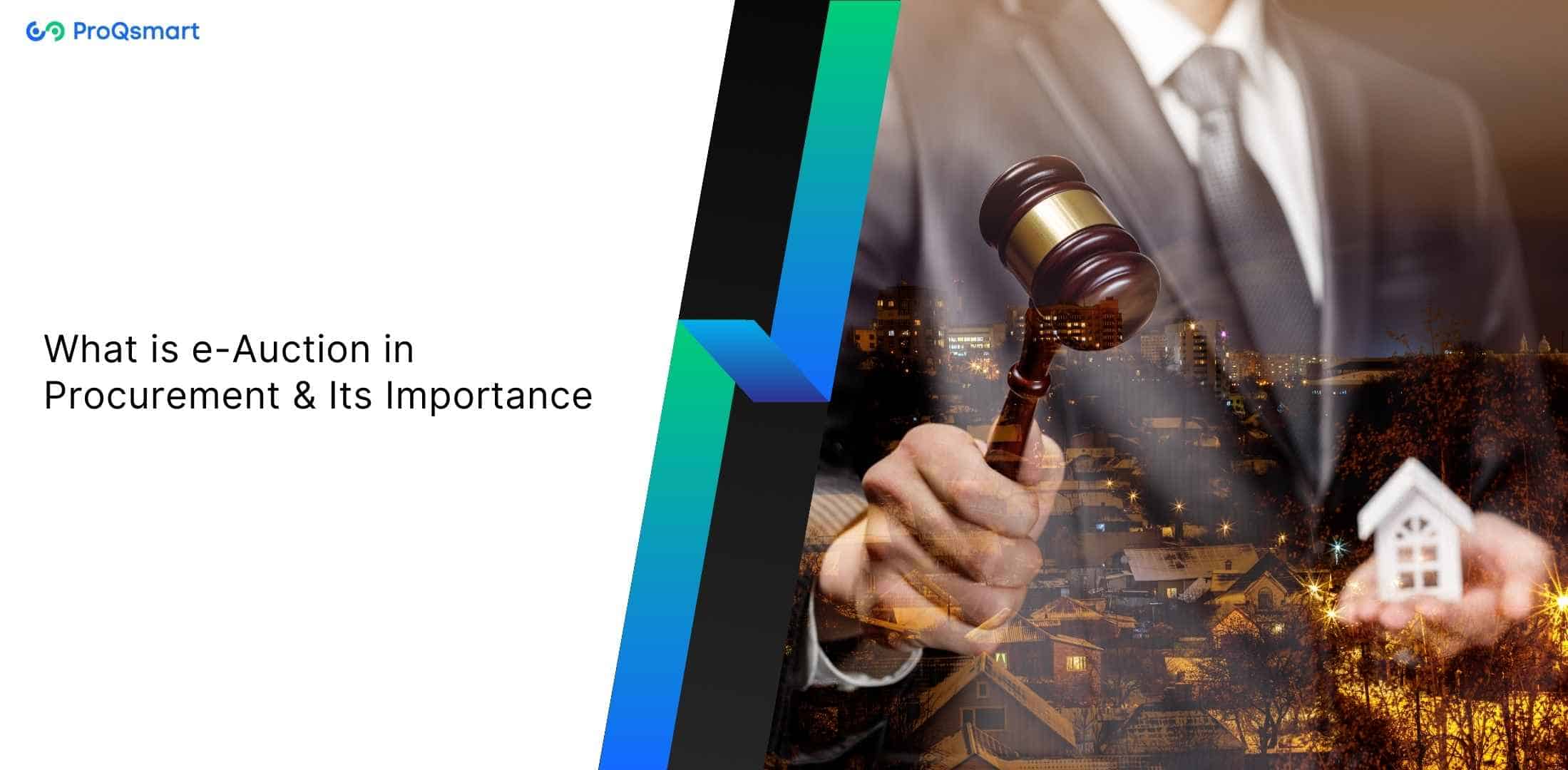E-auctions revolutionize procurement, offering a digital solution that transforms how businesses acquire goods and services. This innovative approach surpasses traditional methods by providing unparalleled transparency and efficiency in the bidding process. By enabling real-time competitive bidding among suppliers, e-auctions unlock significant value for buyers, ensuring optimal pricing and superior outcomes.
The shift towards digital procurement tools like e-auctions is not just a trend but a necessity. As markets evolve rapidly, organizations need agile solutions that can keep pace with change. E-auctions meet this demand by streamlining the procurement process, empowering professionals to make data-driven decisions swiftly and effectively.
Key Takeaways
E-auctions revolutionize procurement by providing a transparent, efficient platform for competitive bidding, significantly improving traditional methods and enhancing overall processes.
Reverse auctions are a game-changer, creating a competitive environment that incentivizes suppliers to lower prices, resulting in substantial cost savings.
E-auctions deliver significant benefits, including cost reductions, increased supplier participation, and improved operational efficiency, enabling organizations to secure optimal pricing and delivery terms.
Challenges like supplier collusion and technical barriers can hinder fair outcomes, making strategic solutions essential for success.
Clear procurement requirements and supplier readiness are critical for effective e-auctions, ensuring better spend management and transparency.
The future of e-auctions is promising, with AI and machine learning driving smarter decisions and transforming procurement through sustainable and ethical sourcing practices.
What is E-Auction in Procurement?
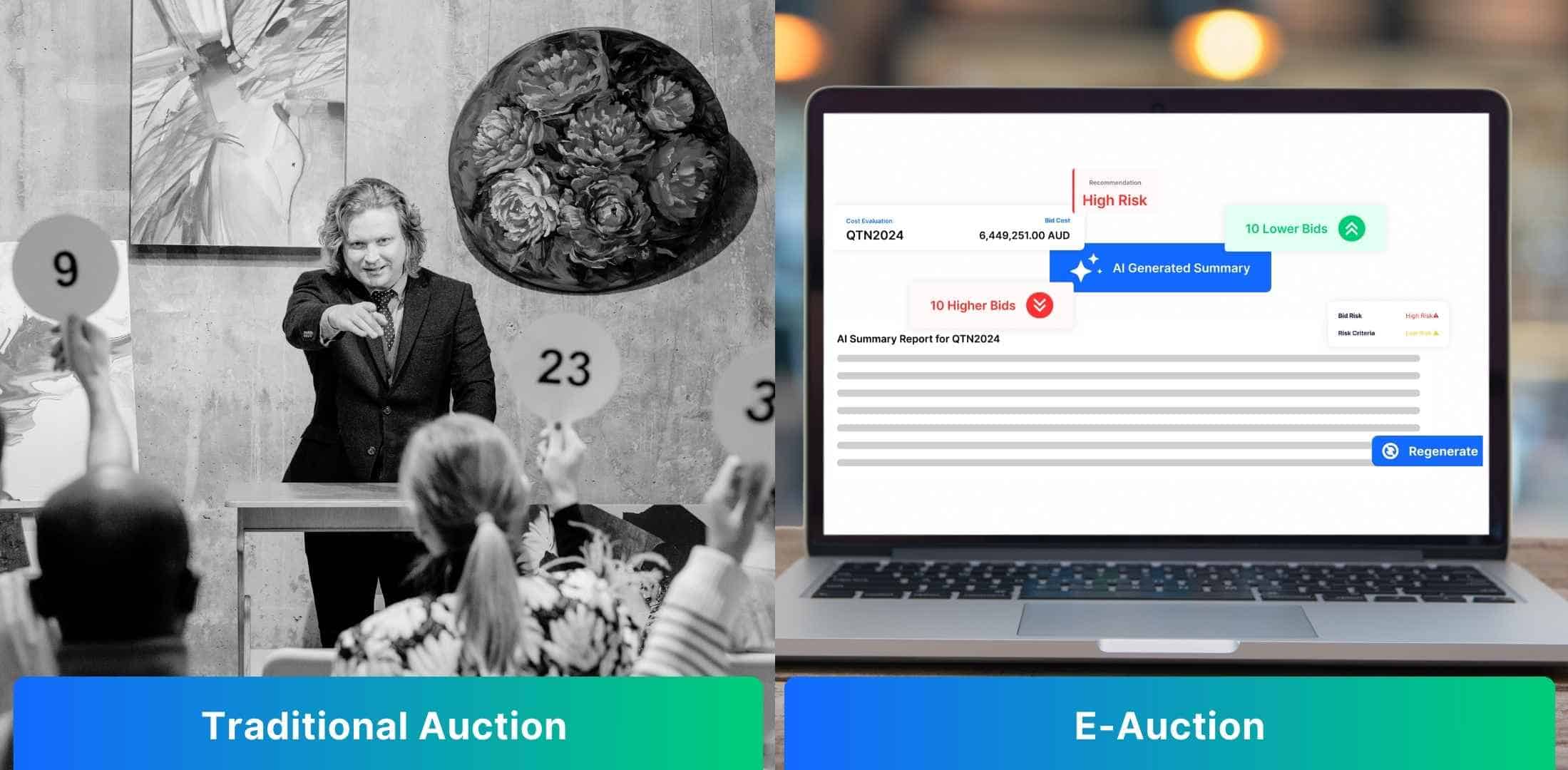
E-auctions are an innovative online auction market that enhances transparency and accountability in public procurement by facilitating efficient, competitive bidding. Unlike traditional auctions, which often necessitate in-person negotiations, e-auctions are conducted as live, online events. This modern approach connects buying entities with a pre-approved pool of vendors, fostering an open, fair, and competitive bidding process that saves time and taxpayer dollars.
The Shift from Traditional Methods to E-Auctions
Transitioning from traditional procurement processes to the e-auction model signifies a major shift in how procurement activities are conducted today. By removing the need for lengthy, one-on-one negotiations with multiple suppliers, the online auction market streamlines processes and boosts efficiency. This model is compatible with various procurement methods, including open, restricted, and competitive procedures with negotiation, providing flexibility across diverse contexts.
This flexibility fosters improved negotiation conditions, with decisions being influenced by data and analytics, while also broadening access to a global market. The electronic auction process involves three main participants:
Buyers:
Seek the best value for their money.
Evaluate bids based on price, quality, and other criteria.
Sellers (Suppliers):
Aim to secure contracts by presenting competitive offers.
Compete with other suppliers to meet buyer requirements.
Auctioneers:
Ensure the auction process runs smoothly.
Enforce established rules and maintain transparency throughout the process.
One common type of e-auction, the reverse auction, is particularly effective for commodity purchases. It prioritizes cost-effectiveness without compromising quality, helping companies save an impressive 10-20% on procurement costs, depending on the goods or services being procured. Overall, e-auctions are a powerful tool for improving transparency, efficiency, and cost savings in procurement.
Types of E-Auctions in Procurement
E-auctions, particularly through an online auction platform, have transformed procurement processes into a more efficient and transparent electronic auction process, revolutionizing the auction ecommerce landscape. Let’s explore the different types of e-auctions to better understand their unique roles in procurement.
Auction Type | Definition | Use Cases | Key Features |
Reverse Auction | Buyers invite suppliers to bid, driving prices down as competition increases. | Effective for cost savings when multiple suppliers compete for a single buyer’s business. | Real-time bidding, competitive pricing, promotes transparency. |
Forward Auction | Suppliers present products/services to buyers, and prices rise as buyers compete. | Suitable for unique or high-demand items where demand outstrips supply. | Price discovery, competitive bidding, dynamic pricing environment. |
Dutch Auction | Starts at a high price, decreasing until a bidder accepts. | Ideal when seeking quick sales or liquidating inventory. | Fast-paced, pressure to bid early, efficient sales mechanism. |
Japanese Auction | Bidders drop out as the price rises, with the last remaining bidder winning. | Effective for high-value items or services with limited supply. | Gradual elimination, competitive pressure, ensures fair pricing. |
Hybrid Auction | Combines features of multiple auction types (e.g., reverse and sealed-bid). | Ideal for complex procurements requiring flexibility. | Customizable rules, adaptable to specific needs, balances competition and control. |
Sealed-Bid Auction | Bidders submit confidential bids, with the highest bid winning. | Used in scenarios where confidentiality is key. | Confidential bids, one-time bidding, competitive without real-time pressure. |
Reverse Auction
Reverse auctions are one of the widely used procurement methods. They are only successful when there is a clear and demonstrated need to drive down costs and encourage competition between suppliers.
Buyers get to ride a downward price wave with suppliers competing against each other for business. This auction type is extremely effective when you have many suppliers competing for the business of one buyer.
It increases transparency and lowers costs dramatically. At least a week’s notice between invitation and auction is advisable to ensure maximum participation.
Reverse auctions offer a unique opportunity to gain deeper insights into the market and uncover the lowest prices suppliers are willing to offer. One of the most compelling examples of this is the Japanese reverse auction, where suppliers continuously lower their bids in real-time, creating a dynamic and competitive environment. This approach not only drives cost savings but also provides a clear picture of market rates, helping buyers make more informed decisions.
Forward Auction
In forward auctions, procurement starts with suppliers making offers to supply goods or services. Buyers compete by driving up the price, which makes this type of auction the right choice for selling one-of-a-kind items.
This format helps drive price discovery and a more competitive bidding environment, especially important for high-demand commodities. Forward auctions are similar to the traditional auction environment but use technology to expand access and opportunity.
Dutch Auction
Dutch auctions start at a high price and lower the price until someone accepts the bid. This approach is best suited for fast-moving items or surplus inventory.
The pressure to bid early creates a fast-paced bidding situation, making it perfect for short sale face-to-face sales situations. Importantly, Dutch auctions are flexible enough to be used on any type of online platform, including one that uses different types of auctions.
Sealed-Bid Auction
Sealed-bid auctions are a procurement method where bidders submit confidential, one-time bids, and the highest or best bid wins. This approach is particularly useful for companies in scenarios where confidentiality is critical, such as competitive supplier negotiations or sensitive procurement processes.
By eliminating real-time competitive pressure, sealed-bid auctions ensure fairness and create a level playing field, making them a reliable choice for high-stakes or confidential business needs.
How E-Auctions Work in Procurement
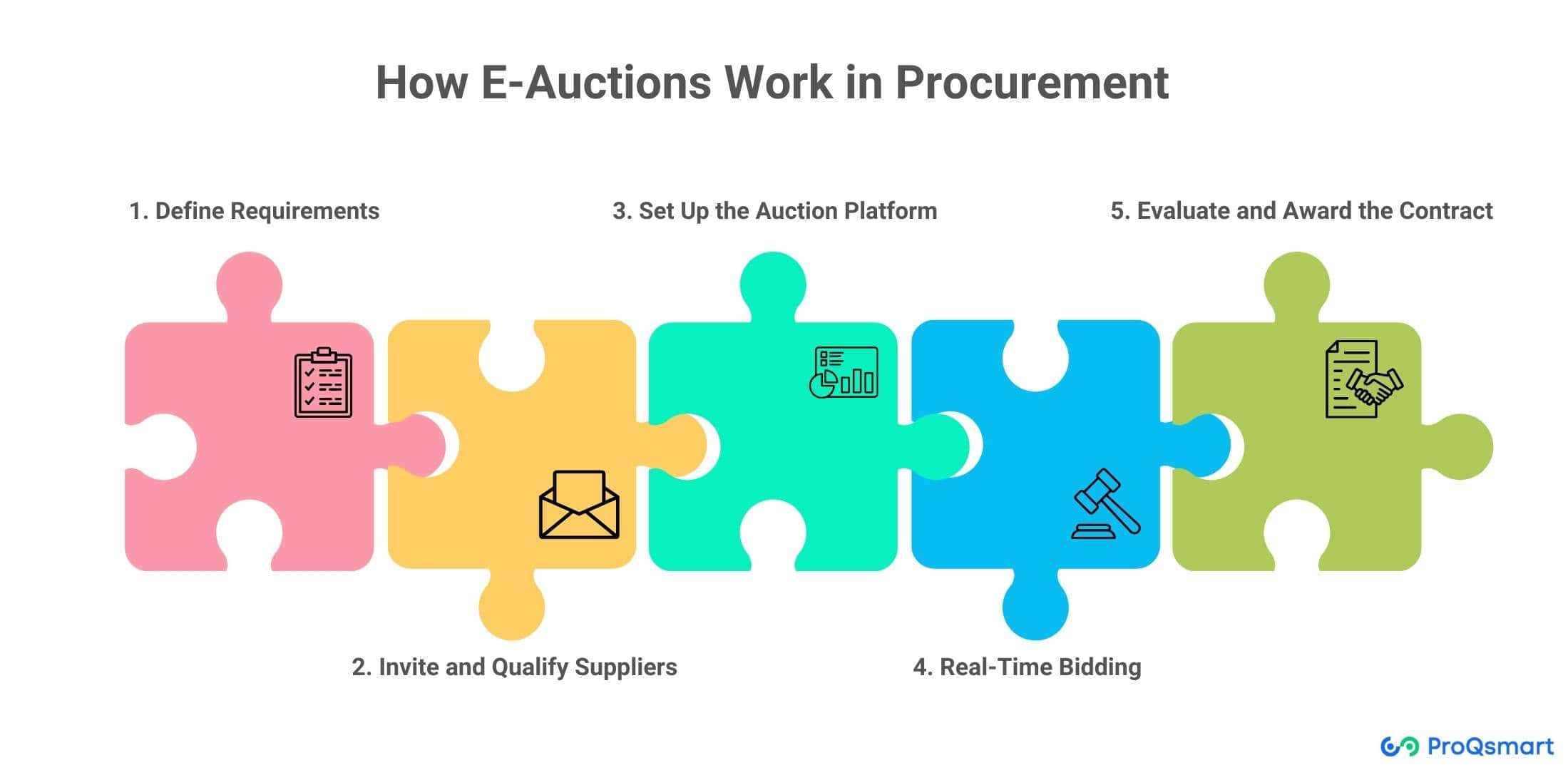
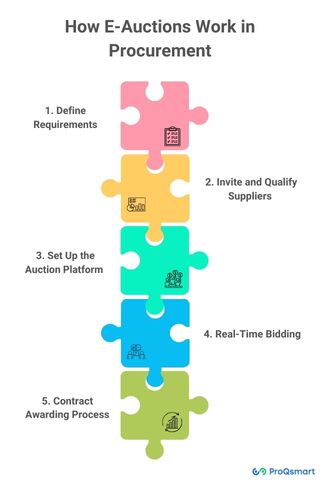
E-auctions serve as a digital procurement tool that streamlines the bidding process, making it faster, more transparent, and cost-effective.
1. Define Requirements
The process begins with the buyer clearly defining their needs. This includes detailed descriptions of the products or services required, such as specifications, quality standards, and delivery timelines. This step also ensures that suppliers understand exactly what is being procured.
2. Invite and Qualify Suppliers
Once the requirements are finalized, the buyer invites suppliers to participate. Suppliers register and undergo a pre-qualification check to ensure they meet the necessary criteria. This step ensures that only qualified suppliers participate in the auction.
3. Set Up the Auction Platform
The buyer configures the e-auction platform with specific rules, timelines, and evaluation criteria to ensure a smooth and transparent process. Advanced platforms like ProQsmart simplify this setup, offering intuitive tools to manage the entire auction lifecycle. ProQsmart supports various auction types, including reverse auctions (where prices start high and decrease as suppliers compete), Dutch auctions (where prices drop until a bidder accepts), and sealed-bid auctions (where bids remain confidential until the auction ends).
Setting up an e-auction on ProQsmart is quick and straightforward. The platform’s user-friendly interface allows buyers to define auction parameters, upload documentation, and invite suppliers in just a few clicks. Automated workflows and real-time notifications ensure all participants stay informed and engaged throughout the process. With ProQsmart, even users new to e-auctions can also configure and manage auctions, making it an ideal choice for organizations looking to enhance transparency, competition, and efficiency in their procurement processes.
4. Real-Time Bidding
During the auction, suppliers bid against each other in real-time. Many platforms allow suppliers to see competing bids, enabling them to adjust their offers strategically. This competitive environment drives better pricing and terms.
5. Evaluate and Award the Contract
Once the auction closes, the buyer evaluates the bids based on predefined criteria, such as price, quality, and delivery terms. The winning bid is selected, and the contract is awarded. The platform provides data and analytics to support informed decision-making.
Importance of E-Auction in Procurement
E-auctions, particularly through an online auction platform, have become a cornerstone of modern procurement, offering a range of benefits that transform how organizations source goods and services.
Cost Savings and Competitive Pricing: E-auctions create a competitive environment where suppliers are motivated to offer their best prices. This dynamic drives significant cost savings for buyers, making procurement more economical and efficient.
Fairness and Transparency: The open and transparent nature of e-auctions ensures a level playing field for all participants. Suppliers can trust the process, knowing that every bid is treated equally, which fosters confidence and encourages broader participation.
Efficiency and Speed: Unlike traditional procurement methods that can be time-consuming, e-auctions streamline the process, reducing negotiation timelines dramatically. This efficiency allows organizations to complete procurement cycles faster, saving time and resources.
Structured and Simultaneous Negotiations: E-auctions enable buyers to engage with multiple suppliers at once, eliminating the need for lengthy one-on-one negotiations.
This structured approach ensures a more organized and efficient procurement process.
Actionable Market Insights: Real-time data and analytics from e-auctions provide procurement teams with valuable insights into market trends and supplier behavior. This information empowers buyers to make informed, data-driven decisions and negotiate better terms.
Compliance and Accountability: E-auctions are conducted on centralized platforms that record all communication and bidding activity. This transparency ensures compliance with procurement policies, reduces the risk of favoritism, and enhances accountability.
Enhanced Supplier Relationships: By fostering a fair and competitive environment, e-auctions help build stronger relationships with suppliers. Suppliers appreciate the transparency and equal opportunity, which can lead to long-term partnerships.
Benefits of E-Auctions
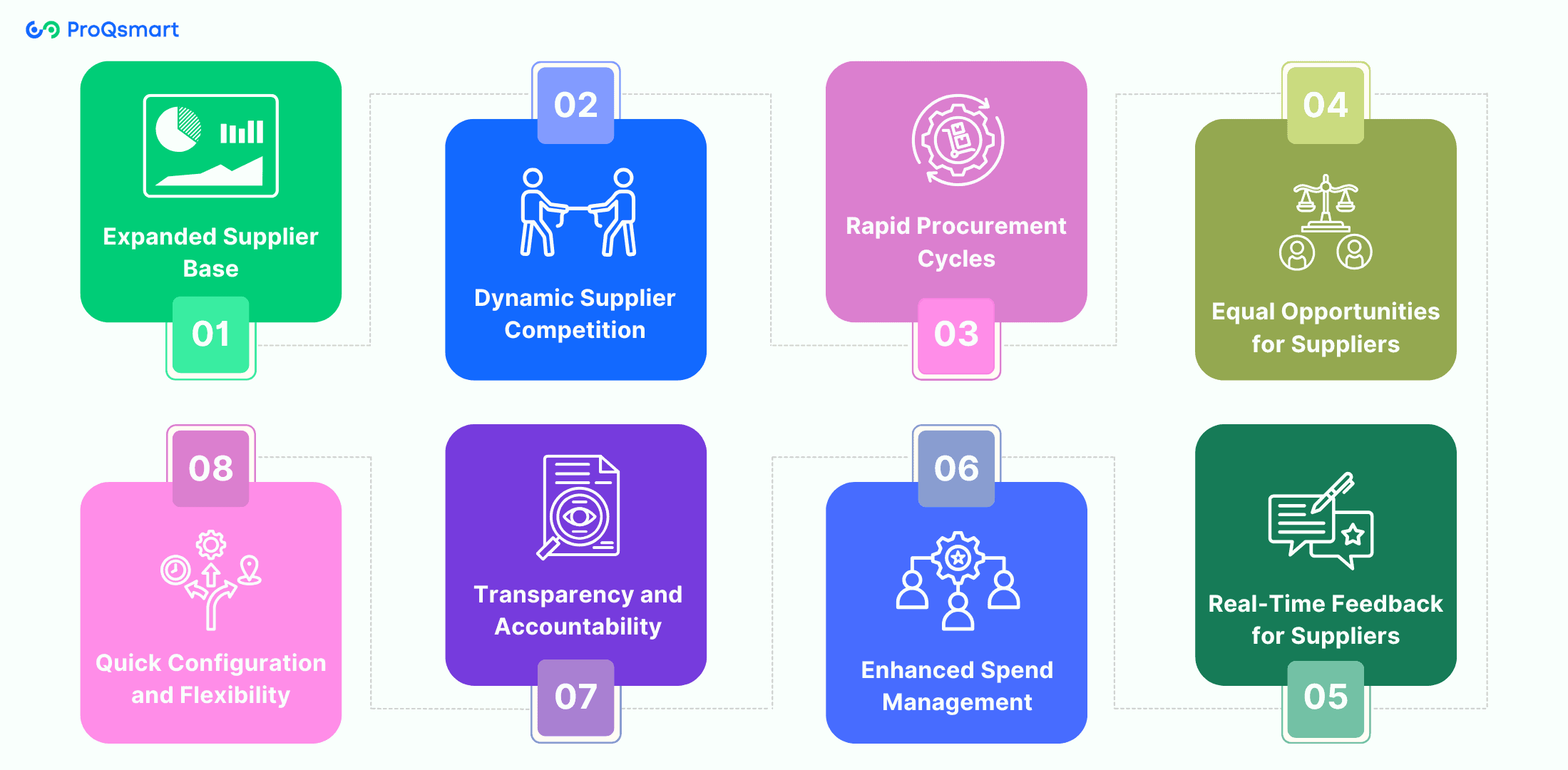
E-auctions offer a wide range of advantages for buyers, suppliers, and procurement professionals, making them a powerful tool in modern procurement.
Expanded Supplier Base: E-auctions enable buyers to tap into a broader pool of suppliers, fostering greater competition and uncovering innovative solutions. This wider reach often leads to creative offerings and better value for buyers.
Dynamic Supplier Competition: The competitive nature of e-auctions pushes suppliers to present their best offers, often resulting in significant cost savings for buyers. This process-driven competition ensures that buyers receive the most favorable terms.
Rapid Procurement Cycles: E-auctions can be completed in a matter of hours, drastically reducing procurement timelines. This speed allows organizations to respond quickly to market demands and operational needs.
Equal Opportunities for Suppliers: E-auctions create a level playing field, giving all suppliers—regardless of size—an equal chance to compete. This fairness helps smaller or newer suppliers break into markets and gain access to business opportunities they might not have otherwise.
Real-Time Feedback for Suppliers: Suppliers receive immediate feedback on their pricing and competitiveness during the auction.
This allows them to adjust their strategies in real-time, fostering a more dynamic and responsive business environment.
Enhanced Spend Management: For procurement professionals, e-auctions provide a streamlined way to manage spend more effectively. The structured process also reduces inefficiencies and ensures that resources are allocated optimally.
Transparency and Accountability: All communications and bids are recorded on a centralized platform, ensuring complete transparency. This not only builds trust among participants but also provides procurement leaders with a clear view of their organization’s procurement health.
Quick Configuration and Flexibility: E-auctions can be set up in less than 24 hours when requirements are clear. This flexibility makes them an ideal solution for urgent or time-sensitive procurement needs.
Best Practices for Successful E-Auctions
Successfully running an e-auction can be a real competitive advantage in procurement for companies. Here’s how to make sure you succeed.
Start by defining clear requirements, including detailed specifications, evaluation criteria, and timelines. This foundational step ensures suppliers understand expectations and reduces the risk of misaligned bids. Without clear guidelines, the auction process can become chaotic, leading to inefficiencies and suboptimal outcomes.
Next, focus on preparing your suppliers.
If suppliers are unfamiliar with e-auction platforms, provide training or resources to help them navigate the process. Supplier readiness is critical—it increases participation, builds confidence, and fosters stronger relationships. A well-prepared supplier pool ensures a competitive and productive auction.
During the auction, ensure fairness and transparency. Implement features like auto-extension minutes to give all suppliers a fair opportunity to bid. Transparent communication about the auction process and results builds trust among stakeholders and ensures alignment. Fairness is key to maintaining supplier confidence and encouraging future participation.
After the auction, monitor and analyze bidding activity using real-time data and analytics. This step helps identify trends, evaluate performance, and uncover areas for improvement. Continuous analysis ensures that each auction is more effective than the last, driving long-term value for your organization.
Finally, integrate e-auctions into your broader procurement strategy. Use them as the final phase of an RFX process, after evaluating non-price factors such as quality, compliance, and delivery timelines. This ensures a balanced approach to supplier selection, where price is just one of many considerations.
Choosing the right e-auction platform is equally important.
Select a solution that aligns with your organization’s needs, such as ProQsmart, which offers AI-driven sourcing, supplier relationship management, and automated workflows. ProQsmart enhances efficiency, transparency, and overall auction performance.
ProQsmart provide functionalities such as e-tenders, supplier performance tracking, and automated workflows. This software also streamline processes, improve transparency, and drive cost savings, ensuring your e-auction strategy is both effective and scalable.
Future of E-Auctions in Procurement
E-auctions are evolving rapidly, driven by AI and machine learning, which empower procurement professionals to make smarter decisions. These technologies analyze data, forecast scenarios, and recommend optimal bidding strategies, enhancing efficiency and transparency.
For example, in the construction industry, data-driven insights help companies anticipate material price fluctuations, labor availability, and project delays, enabling stronger sourcing and planning decisions. E-auctions have transformed procurement for over 25 years, offering unmatched transparency and competition compared to traditional negotiations. Unlike one-on-one discussions, e-auctions allow multiple suppliers to participate simultaneously, fostering greater competition and driving better value for construction projects.
Looking ahead, e-auctions are integrating with technologies like ERP systems, enabling seamless data sharing and greater efficiency. Platforms like ProQsmart leverage AI to streamline procurement, deliver real-time collaboration, and achieve significant cost savings.
Sustainability and ethical sourcing are also becoming central to e-auctions. ProQsmart ensures compliance and transparency, eliminating unethical behavior. Hybrid auction models, combining in-person and virtual elements, are emerging as a global trend, reflecting a shift toward more flexible and adaptive procurement strategies.
Conclusion
E-auctions in procurement introduce transparency and speed. They transform the way that companies procure goods and services, creating competition and enabling value. When designed and executed well, e-auctions bring forth huge cost savings and efficiency. They require focused objectives and careful planning. By embracing technology, cities make more informed procurement decisions and develop better relationships with their suppliers. There are challenges, but they are surmountable with strong planning and implementation. As e-auctions continue to advance, their impact on procurement will become even more powerful, creating new opportunities for innovation.
Ready to take your procurement strategy to the next level? Explore ProQsmart’s E-Auction Solutions and discover how ProQsmart can optimize/streamline your procurement process. Book a demo today!

